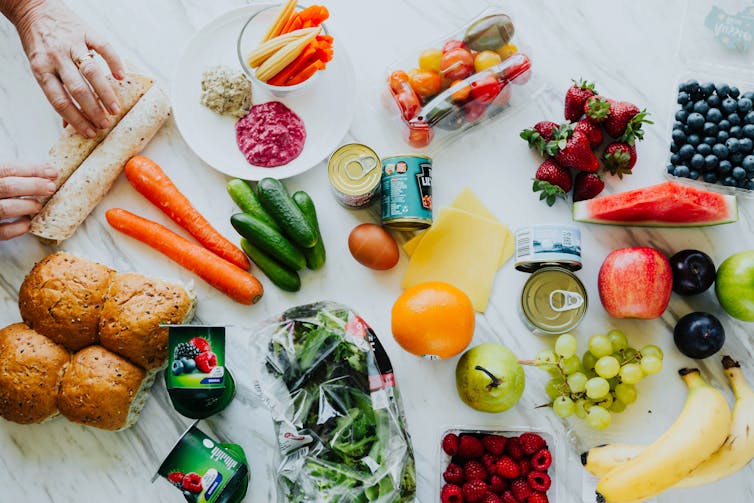Back to work? Take lunch from home to save time and money – and boost your mood
- Written by Clare Collins, Professor in Nutrition and Dietetics, University of Newcastle
Heading back to work after the holidays means turning your thoughts to what’s for lunch. Are you a meticulous lunch planner, or do you only make a decision once those first hunger pangs signal it’s lunchtime?
Whether you bring lunch from home or buy it from a staff canteen or food outlet will depend on the availability of food nearby and whether you have a workplace kitchen with a fridge, microwave and sandwich press.
While it’s easy for work lunch to be an afterthought, there are multiple advantages to bringing your lunch from home and eating in a staff room, rather than at your desk.
Read more: What is a balanced diet anyway?
Planning healthy lunches and eating with others can lower your stress, improve your work performance and help your bank balance – not to mention improve your overall nutrition.
Being organised is worth it
Planning meals for the week ahead gives you more control of your food choices.
The most recent national nutrition survey of 4,500 adults found those who “grazed”, rather than ate regular meals, had poorer diets and were more likely to carry excess weight.
 Rather than thinking about your options at lunchtime, plan and shop for the week ahead.
Minerva Studio/Shutterstock
Rather than thinking about your options at lunchtime, plan and shop for the week ahead.
Minerva Studio/Shutterstock
A 2017 French study of 40,000 adults found those who planned their meals were 13% more likely to have the healthiest eating patterns and 25% more likely to consume a better variety of healthy foods, compared to those who didn’t plan.
The planners also had about a 20% lower risk of having obesity. But we need to keep in mind that this is an association and does not prove causation.
Read more: Want to be happier, healthier, save money? It's time to get cooking
Even doctors report that poor nutrition at work makes them feel irritable, tired, hungry, frustrated and unwell. It makes it harder for them to concentrate, and affects their performance and decision-making.
Workplace interventions to promote healthier eating have included nutrition education, support or counselling to help change behaviours, personalised feedback on nutrition and/or workplace changes such as increased availability of healthier meals, vegetables, fruit and water. These programs have led to small but positive improvements in dietary patterns, lifestyle choices and feelings of wellness.
One study found eating with others at work helped promote social cohesion and boosted poeple’s sense of well-being.
In another study that followed 39,000 Thai adults over four years, researchers found those who ate by themselves were more likely to be unhappy.
 Company is food for the mind.
Shutterstock
Company is food for the mind.
Shutterstock
Put happy food in your lunch box
Having a healthy diet may lower the risk of developing depression, according to a review of the research into diet and depression, which pooled results from 21 studies involving 117,229 people.
The researchers found high intakes of vegetables, fruit, wholegrains, fish, olive oil, low-fat dairy products, and low intakes of animal foods, were associated with a lower risk of depression.
A greater risk was linked to high intakes of red and/or processed meat, refined grains, lollies, high-fat dairy products, butter, potatoes, gravies and low intakes of vegetables and fruit.
In a program aimed at increasing fruit and vegetable intakes in young adults, those who were given two extra serves to eat each day reported an increase in vitality, well-being and motivation compared to those told to stick to their usual (low) intakes.
 Take fruit you actually like, even if it’s a bit more expensive.
Alliance/Shutterstock
Take fruit you actually like, even if it’s a bit more expensive.
Alliance/Shutterstock
Interestingly, participants who were given vouchers to purchase more vegetables and fruit, and sent text message reminders to eat more of them, didn’t increase their fruit and vegetable intake as much as those who were actually given the extra serves.
So having the healthy foods available is key to eating them.
Take lunch to save money
Preparing food at home saves you money. A survey of 437 adults in the United States found those who prepared meals at home more often spent less money on food away from home, less money on food overall, and had healthier dietary intakes.
Australian research shows eating healthily can be more affordable than eating unhealthy foods.
The image below shows the ingredients to make five work lunches that incorporate:
- 3 serves of salad/vegetables
- 2 pieces of fruit
- a tub yoghurt or cheese
- vegetable sticks with some dip for snacks.
 Plan a lunch menu, write a matching shopping list and start saving money.
Bronte Goddensmith 2019
Plan a lunch menu, write a matching shopping list and start saving money.
Bronte Goddensmith 2019
This costs about A$7.50 a day. If you bought a fast-food lunch plus a couple of snacks it could cost A$10-A$15 or more each day.
Over a year, the savings from bringing lunch from home versus buying it adds up to A$600 to A$1,800 for one person.
Read more: We asked five experts: is cheese bad for you?
Pack a healthy lunchbox the night before
You need to be organised to take your own lunch so other factors that influence your food choices don’t hijack good intentions. Try these tips:
1) plan your lunches for the week – write a matching shopping list so you have all the ingredient at your fingertips
2) invest in a lunchbox – pack it the night before and put it in the fridge. That way you minimise time needed in the morning to make lunch
 Be creative so it’s easy to eat healthy food at work.
Image from Rijk Zwaan 2018
Be creative so it’s easy to eat healthy food at work.
Image from Rijk Zwaan 2018
3) try a lunch of leftovers – as you clear away the evening meal, pack leftovers into microwave safe storage containers and refrigerate
4) portion out healthy snacks in small containers – this could include nuts, dip and vegetables such as cherry tomatoes, baby corn, snack cucumbers and carrot sticks.
5) buy a range of fruits you really like – relative to the cost of snacks from vending machines, it’s less expensive and much better for you
6) try making a stack of sandwiches, such as curried egg or cheese on weekends and freeze them
7) make a mini-salad in a snaplock bag using baby cos lettuce cups, cherry tomatoes and capsicum so you can grab and go
8) freeze bottles of water and add one or two to you lunch box to keep food cool on your way to work.
Authors: Clare Collins, Professor in Nutrition and Dietetics, University of Newcastle





